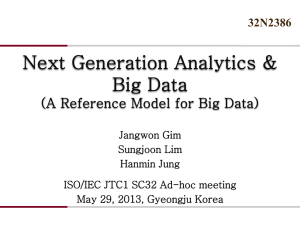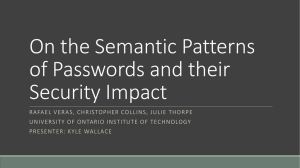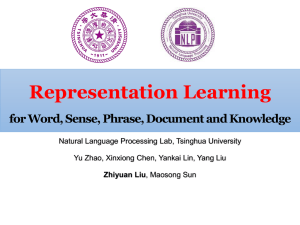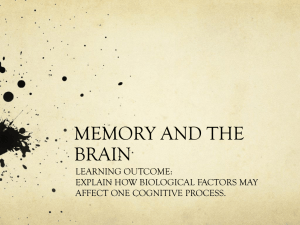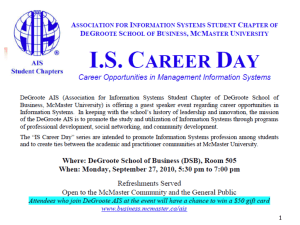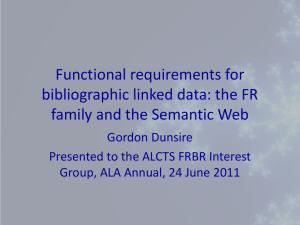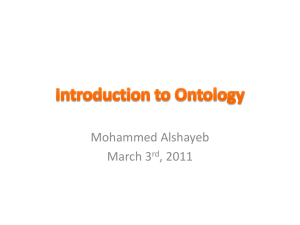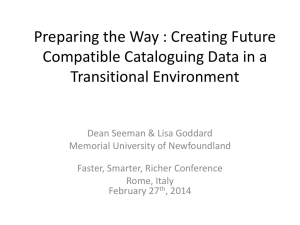Chapter 1: The Semantic Web Vision
advertisement
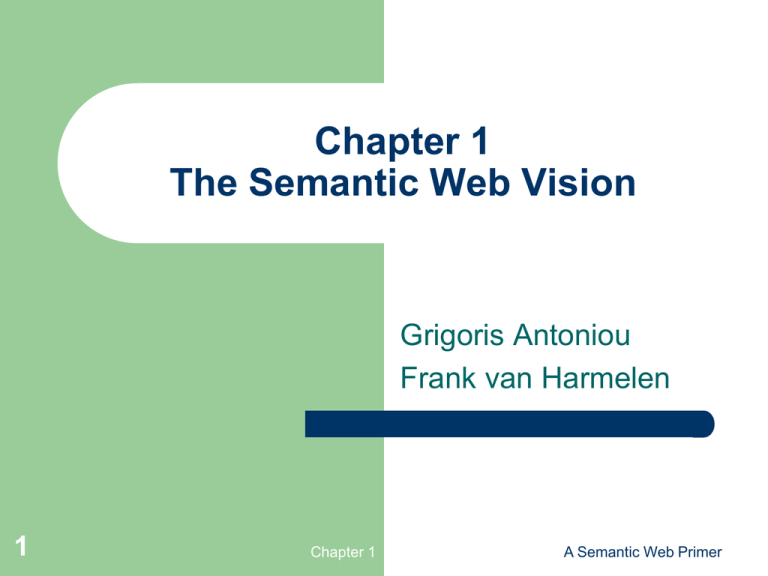
Chapter 1 The Semantic Web Vision Grigoris Antoniou Frank van Harmelen 1 Chapter 1 A Semantic Web Primer Lecture Outline 1. 2. 3. 4. 2 Today’s Web The Semantic Web Impact Semantic Web Technologies A Layered Approach Chapter 1 A Semantic Web Primer Today’s Web Most of today’s Web content is suitable for human consumption – Typical Web uses today people’s – 3 Even Web content that is generated automatically from databases is usually presented without the original structural information found in databases seeking and making use of information, searching for and getting in touch with other people, reviewing catalogs of online stores and ordering products by filling out forms Chapter 1 A Semantic Web Primer Keyword-Based Search Engines Current Web activities are not particularly well supported by software tools – 4 Except for keyword-based search engines (e.g. Google, AltaVista, Yahoo) The Web would not have been the huge success it was, were it not for search engines Chapter 1 A Semantic Web Primer Problems of Keyword-Based Search Engines 5 High recall, low precision. Low or no recall Results are highly sensitive to vocabulary Results are single Web pages Human involvement is necessary to interpret and combine results Results of Web searches are not readily accessible by other software tools Chapter 1 A Semantic Web Primer The Key Problem of Today’s Web 6 The meaning of Web content is not machineaccessible: lack of semantics It is simply difficult to distinguish the meaning between these two sentences: I am a professor of computer science. I am a professor of computer science, you may think. Well, . . . Chapter 1 A Semantic Web Primer The Semantic Web Approach 7 Represent Web content in a form that is more easily machine-processable. Use intelligent techniques to take advantage of these representations. The Semantic Web will gradually evolve out of the existing Web, it is not a competition to the current WWW Chapter 1 A Semantic Web Primer Lecture Outline 1. 2. 3. 4. 8 Today’s Web The Semantic Web Impact Semantic Web Technologies A Layered Approach Chapter 1 A Semantic Web Primer The Semantic Web Impact – Knowledge Management 9 Knowledge management concerns itself with acquiring, accessing, and maintaining knowledge within an organization Key activity of large businesses: internal knowledge as an intellectual asset It is particularly important for international, geographically dispersed organizations Most information is currently available in a weakly structured form (e.g. text, audio, video) Chapter 1 A Semantic Web Primer Limitations of Current Knowledge Management Technologies Searching information – Extracting information – inconsistencies in terminology, outdated information. Viewing information – 10 human involvement necessary for browsing, retrieving, interpreting, combining Maintaining information – Keyword-based search engines Impossible to define views on Web knowledge Chapter 1 A Semantic Web Primer Semantic Web Enabled Knowledge Management 11 Knowledge will be organized in conceptual spaces according to its meaning. Automated tools for maintenance and knowledge discovery Semantic query answering Query answering over several documents Defining who may view certain parts of information (even parts of documents) will be possible. Chapter 1 A Semantic Web Primer The Semantic Web Impact – B2C Electronic Commmerce 12 A typical scenario: user visits one or several online shops, browses their offers, selects and orders products. Ideally humans would visit all, or all major online stores; but too time consuming Shopbots are a useful tool Chapter 1 A Semantic Web Primer Limitations of Shopbots They rely on wrappers: extensive programming required Wrappers need to be reprogrammed when an online store changes its outfit Wrappers extract information based on textual analysis – – 13 Error-prone Limited information extracted Chapter 1 A Semantic Web Primer Semantic Web Enabled B2C Electronic Commerce Software agents that can interpret the product information and the terms of service. – 14 Pricing and product information, delivery and privacy policies will be interpreted and compared to the user requirements. Information about the reputation of shops Sophisticated shopping agents will be able to conduct automated negotiations Chapter 1 A Semantic Web Primer The Semantic Web Impact – B2B Electronic Commerce Greatest economic promise Currently relies mostly on EDI – – – Web appears to be perfect infrastructure – 15 Isolated technology, understood only by experts Difficult to program and maintain, error-prone Each B2B communication requires separate programming But B2B not well supported by Web standards Chapter 1 A Semantic Web Primer Semantic Web Enabled B2B Electronic Commerce 16 Businesses enter partnerships without much overhead Differences in terminology will be resolved using standard abstract domain models Data will be interchanged using translation services. Auctioning, negotiations, and drafting contracts will be carried out automatically (or semi-automatically) by software agents Chapter 1 A Semantic Web Primer Wikis 17 Collections of web pages that allow users to add content via a browser interface Wiki systems allow for collaborative knowledge Users are free to add and change information without ownership of content, access restrictions, or rigid workflows Chapter 1 A Semantic Web Primer Some Uses of Wikis 18 Development of bodies of knowledge in a community effort, with contributions from a wide range of users (e.g. Wikipedia) Knowledge management of an activity or a project (e.g. brainstorming and exchanging ideas, coordinating activities, exchanging records of meetings) Chapter 1 A Semantic Web Primer Semantic Web Enabled Wikis The inherent structure of a wiki, given by the linking between pages, gets accessible to machines beyond mere navigation Structured text and untyped hyperlinks are enriched by semantic annotations referring to an underlying model of the knowledge captured by the wiki − 19 e.g. a hyperlink from Knossos to Heraklion could be annotated with information is located in. This information could then be used for context-specific presentations of pages, advanced querying, and consistency verification Chapter 1 A Semantic Web Primer Lecture Outline 1. 2. 3. 4. 20 Today’s Web The Semantic Web Impact Semantic Web Technologies A Layered Approach Chapter 1 A Semantic Web Primer Semantic Web Technologies 21 Explicit Metadata Ontologies Logic and Inference Agents Chapter 1 A Semantic Web Primer On HTML 22 Web content is currently formatted for human readers rather than programs HTML is the predominant language in which Web pages are written (directly or using tools) Vocabulary describes presentation Chapter 1 A Semantic Web Primer An HTML Example <h1>Agilitas Physiotherapy Centre</h1> Welcome to the home page of the Agilitas Physiotherapy Centre. Do you feel pain? Have you had an injury? Let our staff Lisa Davenport, Kelly Townsend (our lovely secretary) and Steve Matthews take care of your body and soul. <h2>Consultation hours</h2> Mon 11am - 7pm<br> Tue 11am - 7pm<br> Wed 3pm - 7pm<br> Thu 11am - 7pm<br> Fri 11am - 3pm<p> But note that we do not offer consultation during the weeks of the <a href=". . .">State Of Origin</a> games. 23 Chapter 1 A Semantic Web Primer Problems with HTML Humans have no problem with this Machines (software agents) do: – – – 24 How distinguish therapists from the secretary, How determine exact consultation hours They would have to follow the link to the State Of Origin games to find when they take place. Chapter 1 A Semantic Web Primer A Better Representation <company> <treatmentOffered>Physiotherapy</treatmentOffered> <companyName>Agilitas Physiotherapy Centre</companyName> <staff> <therapist>Lisa Davenport</therapist> <therapist>Steve Matthews</therapist> <secretary>Kelly Townsend</secretary> </staff> </company> 25 Chapter 1 A Semantic Web Primer Explicit Metadata This representation is far more easily processable by machines Metadata: data about data – 26 Metadata capture part of the meaning of data Semantic Web does not rely on text-based manipulation, but rather on machineprocessable metadata Chapter 1 A Semantic Web Primer Ontologies The term ontology originates from philosophy The study of the nature of existence Different meaning from computer science An ontology is an explicit and formal specification of a conceptualization 27 Chapter 1 A Semantic Web Primer Typical Components of Ontologies Terms denote important concepts (classes of objects) of the domain – Relationships between these terms: typically class hierarchies – – 28 e.g. professors, staff, students, courses, departments a class C to be a subclass of another class C' if every object in C is also included in C' e.g. all professors are staff members Chapter 1 A Semantic Web Primer Further Components of Ontologies Properties: – Value restrictions – e.g. faculty and general staff are disjoint Logical relationships between objects – 29 e.g. only faculty members can teach courses Disjointness statements – e.g. X teaches Y e.g. every department must include at least 10 faculty Chapter 1 A Semantic Web Primer Example of a Class Hierarchy 30 Chapter 1 A Semantic Web Primer The Role of Ontologies on the Web Ontologies provide a shared understanding of a domain: semantic interoperability – – 31 overcome differences in terminology mappings between ontologies Ontologies are useful for the organization and navigation of Web sites Chapter 1 A Semantic Web Primer The Role of Ontologies in Web Search Ontologies are useful for improving the accuracy of Web searches – Web searches can exploit generalization/ specialization information – – 32 search engines can look for pages that refer to a precise concept in an ontology If a query fails to find any relevant documents, the search engine may suggest to the user a more general query. If too many answers are retrieved, the search engine may suggest to the user some specializations. Chapter 1 A Semantic Web Primer Web Ontology Languages RDF Schema RDF is a data model for objects and relations between them RDF Schema is a vocabulary description language Describes properties and classes of RDF resources Provides semantics for generalization hierarchies of properties and classes 33 Chapter 1 A Semantic Web Primer Web Ontology Languages (2) OWL A richer ontology language relations between classes – cardinality – 34 e.g., disjointness e.g. “exactly one” richer typing of properties characteristics of properties (e.g., symmetry) Chapter 1 A Semantic Web Primer Logic and Inference Logic is the discipline that studies the principles of reasoning Formal languages for expressing knowledge Well-understood formal semantics – 35 Declarative knowledge: we describe what holds without caring about how it can be deduced Automated reasoners can deduce (infer) conclusions from the given knowledge Chapter 1 A Semantic Web Primer An Inference Example prof(X) faculty(X) faculty(X) staff(X) prof(michael) We can deduce the following conclusions: faculty(michael) staff(michael) prof(X) staff(X) 36 Chapter 1 A Semantic Web Primer Logic versus Ontologies The previous example involves knowledge typically found in ontologies – – Logic is more general than ontologies – 37 Logic can be used to uncover ontological knowledge that is implicitly given It can also help uncover unexpected relationships and inconsistencies It can also be used by intelligent agents for making decisions and selecting courses of action Chapter 1 A Semantic Web Primer Tradeoff between Expressive Power and Computational Complexity The more expressive a logic is, the more computationally expensive it becomes to draw conclusions – Our previous examples involved rules “If conditions, then conclusion,” and only finitely many objects – 38 Drawing certain conclusions may become impossible if noncomputability barriers are encountered. This subset of logic is tractable and is supported by efficient reasoning tools Chapter 1 A Semantic Web Primer Inference and Explanations 39 Explanations: the series of inference steps can be retraced They increase users’ confidence in Semantic Web agents: “Oh yeah?” button Activities between agents: create or validate proofs Chapter 1 A Semantic Web Primer Typical Explanation Procedure Facts will typically be traced to some Web addresses – 40 The trust of the Web address will be verifiable by agents Rules may be a part of a shared commerce ontology or the policy of the online shop Chapter 1 A Semantic Web Primer Software Agents Software agents work autonomously and proactively – A personal agent on the Semantic Web will: – – – – 41 They evolved out of object oriented and compontent-based programming receive some tasks and preferences from the person seek information from Web sources, communicate with other agents compare information about user requirements and preferences, make certain choices give answers to the user Chapter 1 A Semantic Web Primer Intelligent Personal Agents 42 Chapter 1 A Semantic Web Primer Semantic Web Agent Technologies Metadata – Ontologies – – Web searches, interpret retrieved information Communicate with other agents Logic – 43 Identify and extract information from Web sources Process retrieved information, draw conclusions Chapter 1 A Semantic Web Primer Semantic Web Agent Technologies (2) Further technologies (orthogonal to the Semantic Web technologies) – – – 44 Agent communication languages Formal representation of beliefs, desires, and intentions of agents Creation and maintenance of user models. Chapter 1 A Semantic Web Primer Lecture Outline 1. 2. 3. 4. 45 Today’s Web The Semantic Web Impact Semantic Web Technologies A Layered Approach Chapter 1 A Semantic Web Primer A Layered Approach The development of the Semantic Web proceeds in steps – Each step building a layer on top of another Principles: Downward compatibility Upward partial understanding 46 Chapter 1 A Semantic Web Primer The Semantic Web Layer Tower 47 Chapter 1 A Semantic Web Primer An Alternative Layer Stack − − 48 Takes recent developments into account The main differences are: The ontology layer is instantiated with two alternatives: the current standard Web ontology language, OWL, and a rulebased language DLP is the intersection of OWL and Horn logic, and serves as a common foundation The Semantic Web Architecture is currently being debated and may be subject to refinements and modifications in the future. Chapter 1 A Semantic Web Primer Alternative Semantic Web Stack 49 Chapter 1 A Semantic Web Primer Semantic Web Layers XML layer – RDF layer – – RDF basic data model for facts RDF Schema simple ontology language Ontology layer – – 50 Syntactic basis More expressive languages than RDF Schema Current Web standard: OWL Chapter 1 A Semantic Web Primer Semantic Web Layers (2) Logic layer – – Proof layer – Proof generation, exchange, validation Trust layer – – 51 enhance ontology languages further application-specific declarative knowledge Digital signatures recommendations, rating agencies …. Chapter 1 A Semantic Web Primer Book Outline 2. 3. 4. 5. 6. 7. 8. 52 Structured Web Documents in XML Describing Web Resources in RDF Web Ontology Language: OWL Logic and Inference: Rules Applications Ontology Engineering Conclusion and Outlook Chapter 1 A Semantic Web Primer
